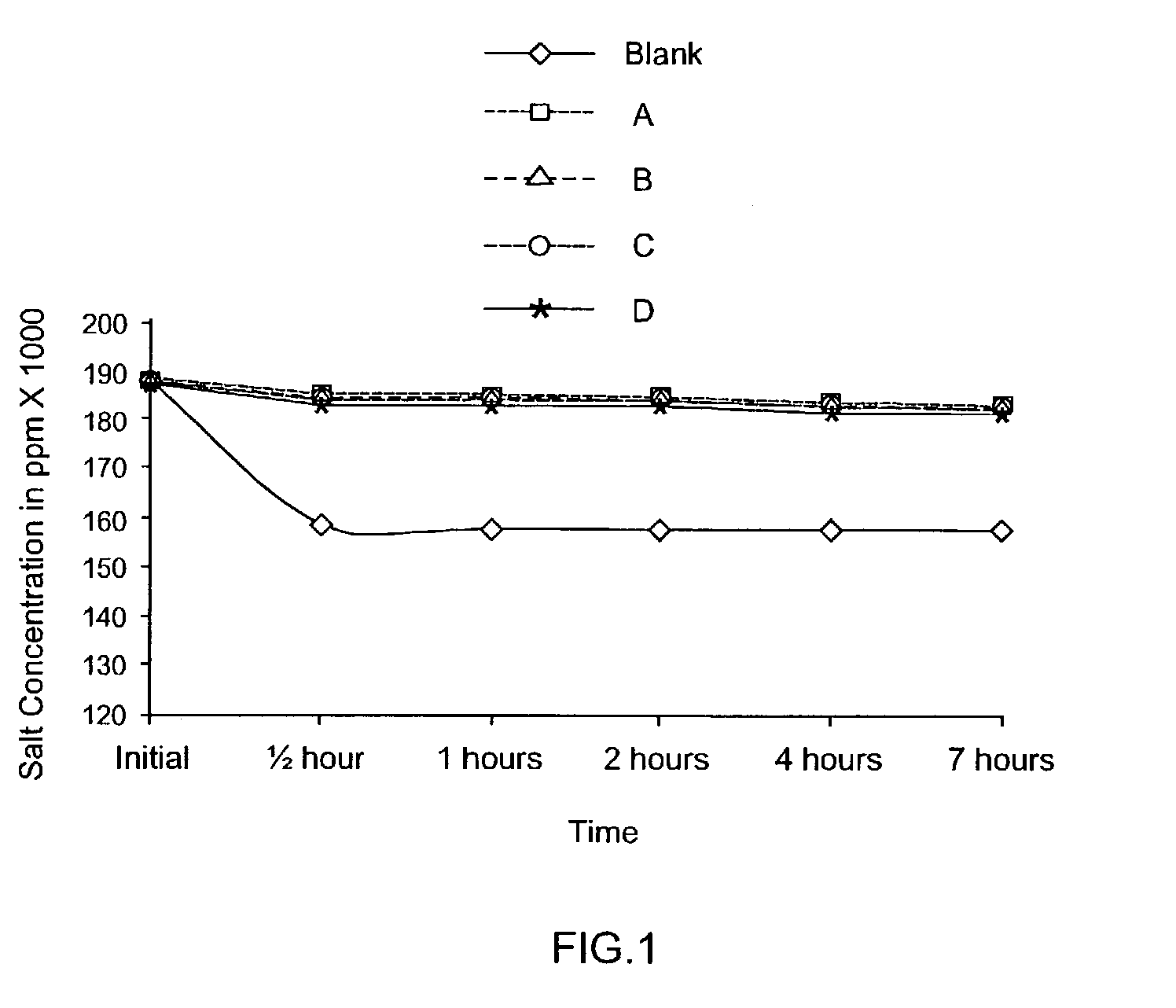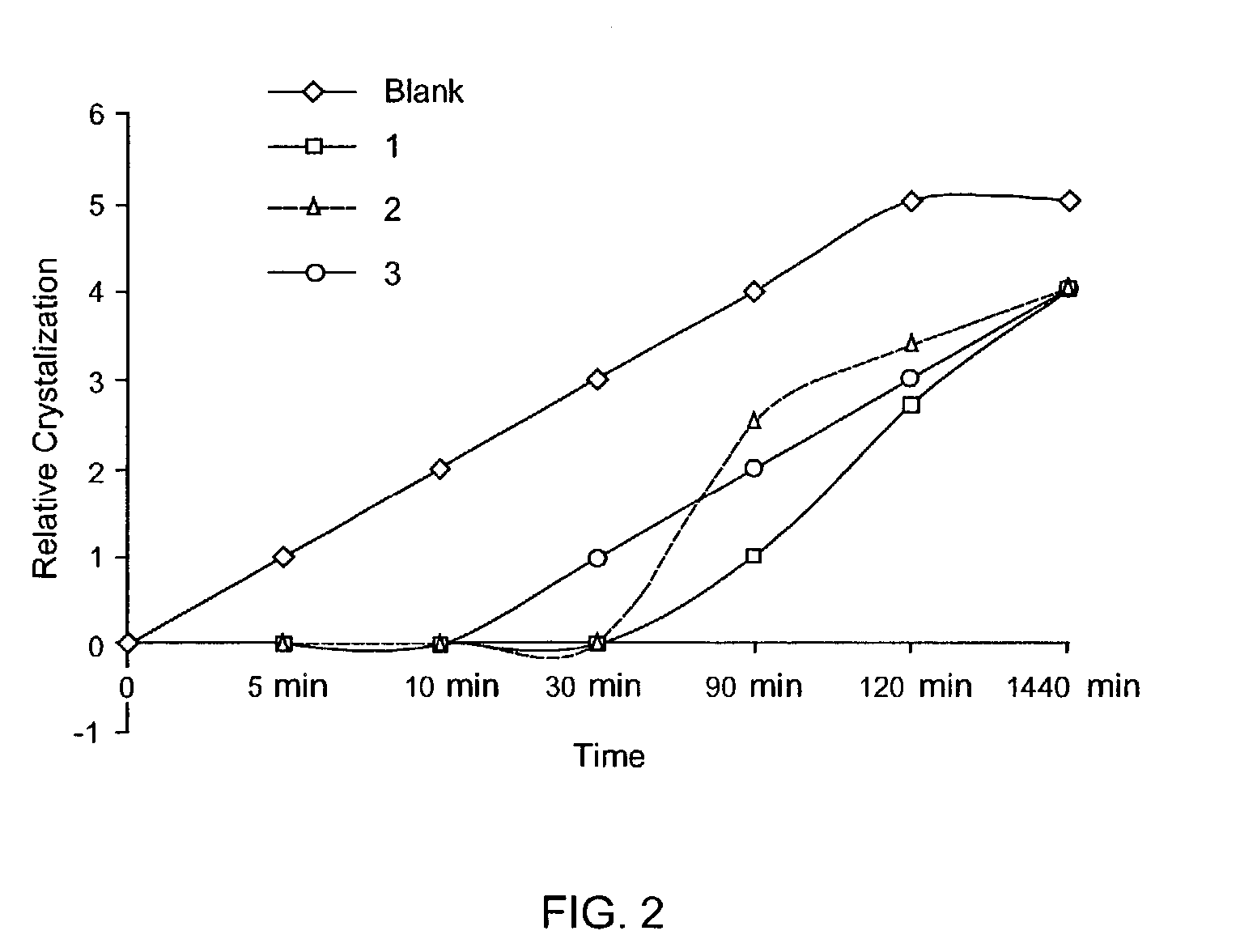Methods for the inhibition of salt blockages in oil and gas wells
a technology for oil and gas wells and salt, which is applied in the direction of wellbore/well accessories, sealing/packing, chemistry apparatus and processes, etc. it can solve the problems of increasing the solubility of salt in solution, inconvenient processing, and high cost of treatment, so as to reduce or eliminate the formation of salt deposits, reduce or minimize the precipitation of salts, and facilitate the removal of water
- Summary
- Abstract
- Description
- Claims
- Application Information
AI Technical Summary
Benefits of technology
Problems solved by technology
Method used
Image
Examples
example 1
[0027]A saturated sodium chloride solution (298 grams sodium chloride and 800 milliliters deionized water) and a solution containing calcium chloride and sodium chloride (201.28 grams calcium chloride dihydrate, 32 grams sodium chloride, and 351 milliliters deionized water) were prepared. A volume of 59 milliliters of the sodium chloride solution and 23.4 milliliters of the calcium chloride brine were combined. This results in a relatively large supersaturation essentially instantly upon mixing.
[0028]The effectiveness of four commonly used inhibitor types was investigated. An inorganic salt (as described in U.S. Pat. No. 5,396,958), two polymers (obtained from Clearwater, Inc.), and an organic oligomer (aspartic acid polymer obtained from Donlar Corporation, Bedford Park, Ill.) were evaluated at 250 ppm concentrations. After crystallization, the amount of salt remaining in solution was determined over time (FIG. 1). In the figure, Inhibitor A is DeSalt (JACAM Che...
example 2
[0030]The solutions used in Example 1 were placed in a 200° F. (93° C.) constant temperature water bath and allowed to thermally equilibrate prior to mixing. After mixing, the solutions were kept in the water bath for an additional 30 minutes. The mixtures were removed, and placed at room temperature. The samples were observed at regular intervals for evidence of precipitation (FIG. 2). In the Figure, Inhibitor #1 is NA Minus 55 (Clearwater, Inc.; Houston, Tex.), Inhibitor #2 is an experimental salt inhibitor (Donlar Corporation; Bedford Park, Ill.), and Inhibitor #3 is NA Minus 55 (3801 experimental variation of NA Minus 55; Clearwater, Inc.; Houston, Tex.). The presence of inhibitors delayed the onset of crystal nucleation.
example 3
Tube Blocking Test
[0031]Solutions were prepared at varying inhibitor concentrations as described in Example 1, using NA Minus 55 as the salt inhibitor. The solutions were placed in a 190° F. (88° C.) constant temperature water bath and allowed to thermally equilibrate. The solutions were introduced into a mixing “tee” using peristaltic pumps. The mixed solution was then pumped into a five foot (1.5 meter) long ⅛ inch (0.3 cm) stainless steel tube which was also immersed in the water bath. The mixed solution next entered a test coil consisting of one meter of 0.02 inch (0.05 cm) PEEK tubing immersed in a 40° F. (4° C.) thermostatically controlled cooling bath. The outlet temperature of the test coil was measured to be 43–45° F. (6–7° C.) throughout the test. The threshold treatment level for inhibition of this brine was found to be about 50 ppm. A plot of the differential pressure against time is shown in FIG. 3. At 20 ppm, the onset of pressure increase was delayed, and at 50 ppm, t...
PUM
| Property | Measurement | Unit |
|---|---|---|
| volume | aaaaa | aaaaa |
| volume | aaaaa | aaaaa |
| temperature | aaaaa | aaaaa |
Abstract
Description
Claims
Application Information
 Login to View More
Login to View More - R&D
- Intellectual Property
- Life Sciences
- Materials
- Tech Scout
- Unparalleled Data Quality
- Higher Quality Content
- 60% Fewer Hallucinations
Browse by: Latest US Patents, China's latest patents, Technical Efficacy Thesaurus, Application Domain, Technology Topic, Popular Technical Reports.
© 2025 PatSnap. All rights reserved.Legal|Privacy policy|Modern Slavery Act Transparency Statement|Sitemap|About US| Contact US: help@patsnap.com



